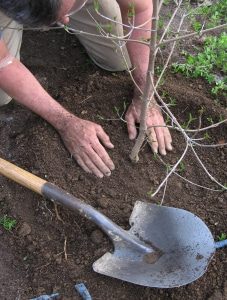With cooler temperatures just around the corner, it is an ideal time to prepare your yard and fall is the perfect time to plant a tree. The weather conditions during the fall months give trees a chance to establish their roots before the warmer temperatures stimulate major growth.
We’ve put together our top tips for tree planting to help your new tree adjust quickly in its new environment:
- Find the trunk flare; this is the point of the tree where the trunk expands at the base and literally flares out. The trunk flare should be somewhat visible after the tree has been planted.
- Dig a hole that is shallow and broad; the hole should be two to three times wider than the root ball. A broad hole gives the tree’s emerging roots a chance to expand and breaks up the surrounding soil.
- Find the correct hole height for the tree; only dig the hole to the proper depth, no deeper. Most tree roots grow in the top 12 inches of soil. You want to avoid planting your tree too deeply (no more than 1 foot deep) as this cuts off oxygen supply to the tree and stops new roots from developing. When you are placing the tree in the hole, hold it by the root ball, not the flare. In areas with poor drainage, trees can be planted two to three inches above grade.
- Make sure the tree stands straight; view the tree from several angles before filling the hole. Once your tree is planted it is very difficult to change its position.
- Firmly fill in the hole; you want to be gentle, but make sure to pack the soil around the base of the root ball. Packing the soil eliminates air pockets that can dry out the roots. You will want to avoid fertilization during the planting process.
- Stake the tree; we highly recommend this step, especially with the number of tree casualties that occur during monsoon. This stabilizes the tree allowing it to develop a stronger trunk and root system.
- Cover the base in mulch; this organic material helps the tree maintain moisture, while regulating extreme soil temperatures and reducing grass and weed competition. Don’t use more than four inches of mulch and leave a one to two inch gap around the base of the tree. This prevents decay and helps maintain the level of moisture a tree needs.
- Water the tree; you should water new trees at least once a week. The soil should be moist, but not waterlogged. Keep this frequency of watering until mid-fall. Trees require less water in the cooler months. Prune sparingly, it is recommended to delay corrective pruning until the tree has had a full season of growth.
If you are an SRP customer you are eligible to sign up for their tree planting workshops around the Valley, which entitles you to become part of the SRP Tree Shading Program.


